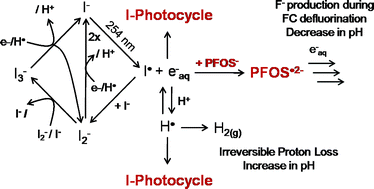Reductive degradation of perfluoroalkyl compounds with aquated electrons generated from iodide photolysis at 254 nm†
Abstract
The perfluoroalkyl compounds (PFCs), perfluoroalkyl sulfonates (PFXS) and perfluoroalkyl carboxylates (

* Corresponding authors
a
School of Energy Engineering, Kyungpook National University, Daegu, Korea
E-mail:
hwp@knu.ac.kr
Tel: +82-53-950-7371
b School of Engineering and Applied Sciences, Harvard University, Cambridge
c W. M. Keck Laboratories, California Institute of Technology, Pasadena, California
d Environmental Analysis Center, California Institute of Technology, Pasadena, California
e 3M Environmental Laboratory, 3M Center, Building 260-05-N-17, Maplewood, Minnesota
The perfluoroalkyl compounds (PFCs), perfluoroalkyl sulfonates (PFXS) and perfluoroalkyl carboxylates (

 Please wait while we load your content...
Something went wrong. Try again?
Please wait while we load your content...
Something went wrong. Try again?
H. Park, C. D. Vecitis, J. Cheng, N. F. Dalleska, B. T. Mader and M. R. Hoffmann, Photochem. Photobiol. Sci., 2011, 10, 1945 DOI: 10.1039/C1PP05270E
To request permission to reproduce material from this article, please go to the Copyright Clearance Center request page.
If you are an author contributing to an RSC publication, you do not need to request permission provided correct acknowledgement is given.
If you are the author of this article, you do not need to request permission to reproduce figures and diagrams provided correct acknowledgement is given. If you want to reproduce the whole article in a third-party publication (excluding your thesis/dissertation for which permission is not required) please go to the Copyright Clearance Center request page.
Read more about how to correctly acknowledge RSC content.
 Fetching data from CrossRef.
Fetching data from CrossRef.
This may take some time to load.
Loading related content
